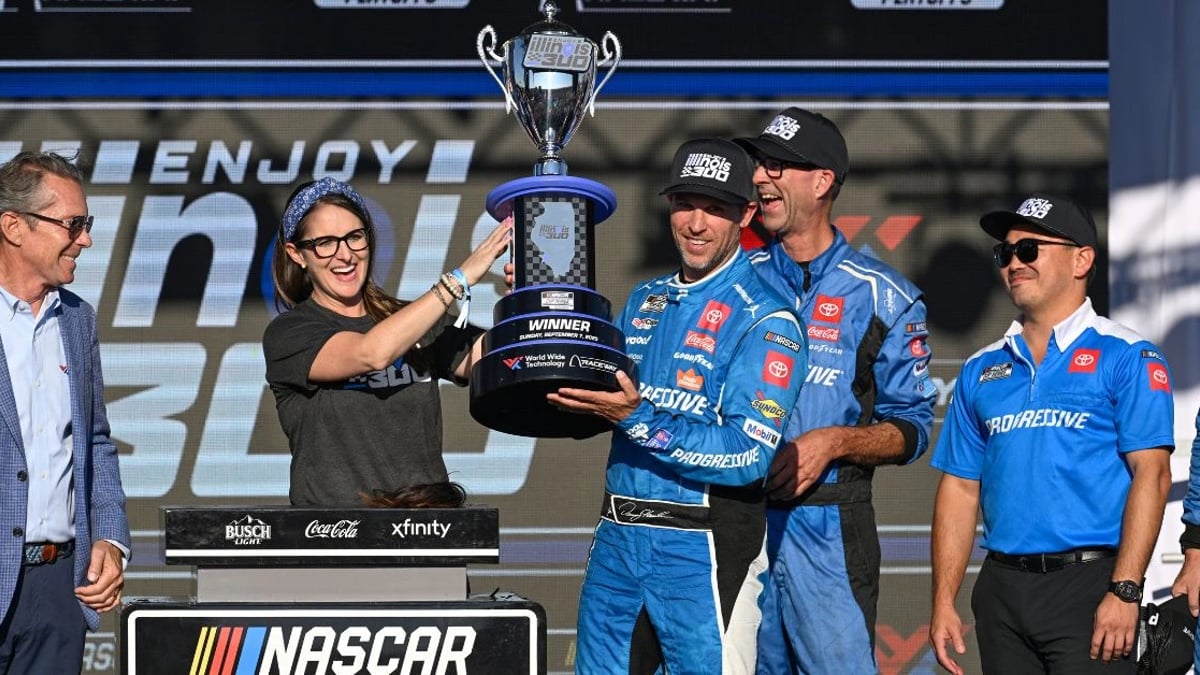NASCAR Betting Strategy: Keys to Success & Bet Types

NASCAR, founded in 1948, is North America’s premier stock car racing series, featuring 36 races across multiple track types.
- #ad. 18+. Gamble Responsibly. Gambleaware.org. GAMBLING PROBLEM? CALL 1-800-GAMBLER, (800) 327-5050 or visit http://gamblinghelplinema.org (MA). Call 877-8-HOPENY/text HOPENY (467369) (NY). Please Gamble Responsibly. 888-789-7777/visit http://ccpg.org (CT), or visit www.mdgamblinghelp.org (MD). 21+ and present in most states. (18+ DC/KY/NH/WY). Void in ONT/OR/NH. Eligibility restrictions apply. On behalf of Boot Hill Casino & Resort (KS). Pass-thru of per wager tax may apply in IL. 1 per new customer. Must register new account to receive reward Token. Must select Token BEFORE placing min. $5 bet to receive $200 in Bonus Bets if your bet wins. Min. -500 odds req. Token and Bonus Bets are single-use and non-withdrawable. Token expires 1/11/26. Bonus Bets expire in 7 days (168 hours). Stake removed from payout. Terms: http://sportsbook.draftkings.com/promos . Ends 1/4/26 at 11:59 PM ET. Sponsored by DK.
Types of NASCAR Bets
Online betting sites offer various wagering types for every race.
NASCAR betting odds utilize the same systems as those of most other popular sports, making them accessible even to beginners. Most sportsbooks display American odds formats, but you can usually change them depending on your preference.
- Race Winner: This is the most common wager, where you pick a specific driver or team to win the entire race. Betting on favorites will yield smaller profits compared to long-shot contenders.
- Top 3/5/10 Finish: Instead of betting on an outright win, you can wager on a driver to finish within a specific position bracket, such as the top three, top five, or even top ten, given that NASCAR fields can comprise up to 40 drivers.
- Head-to-Head Matchups: The overall race winner is irrelevant in this bet type. You bet on one specific driver to finish higher than another.
- Group Betting: Similar to head-to-head matchups, group betting involves wagering on a driver to finish ahead of their competitors within a pre-defined group of racers.
- Prop Bets (Proposition Bets): While less common in NASCAR, these allow you to wager on outcomes that aren't necessarily related to final driver positions. Examples include betting on which driver will finish highest for a particular manufacturer (e.g., Ryan Blaney as the top-finishing Ford), the number of laps a driver will lead, or the number of caution flags in a race.
How the NASCAR Cup Series Playoffs Work
Since 2014, NASCAR has implemented a format that breaks the year into 26 regular-season races and then a 10-race playoff to decide the title. Sixteen drivers qualify for the postseason, with four eliminated in each of the opening four race rounds based on point totals.
A win automatically gets you both into the postseason and moves drivers to the next round of the playoffs. The three rounds boil down to the four eligible drivers after the third round, who move on to the season's last race.
The race within a race is between that quartet with the highest finisher among the group claiming the crown.
As drivers navigate the gauntlet of the grueling season, three keys have historically led to winning the championship.
Characteristics of a NASCAR Champion
There are several common trends to remember when betting on NASCAR Cup Series champions. While the format for crowning a champ has changed several times, similar trends can be applied to breaking down the championship contenders over the last decade.
Betting on the NASCAR Cup Series isn’t just picking the fastest driver. Look for someone with a strong track record, steady performance week after week, and the discipline to stay out of trouble.
After all, the best drivers don’t just win races—they know how to manage an entire season.
Wins Matter More Than Ever
The driver with the most wins throughout the season isn’t automatically the champ. However, winning is the best avenue for success, as they say.
Since the 2010 season, championship driver win totals have been impressive. Joey Logano’s 2018 title saw him win three times, the lowest number over the last 15 years. Excluding Logano's unique 2018 season, the average is just under five victories.
A win early in the regular season guarantees an automatic playoff berth and relieves a lot of pressure. Victories during playoff rounds carry advancement and provide opportunities for teams to try different setups or nuances.
The bottom line is that drivers capable of multiple win seasons, while not a lock, still are the best bets on NASCAR betting sites to win the title.

Consistency Is Crucial
Equally important is regularly staying and finishing near the front of the field. Points are distributed to the top-10 finishes at the end of the two stages inside a race that leads up to the final leg to the checkered flag. Racking up those valuable markers is a safety net for drivers who don’t win.
Six of the last 10 champions have put more than 20 top-10 finishes in the books, with high-water marks in 2017 and 2018 when Martin Truex Jr. and Logano scored 26 each year.
Every position on the track counts for a point, and what might seem like a meaningless eleventh-place finish in June could come back to haunt a driver later on in the playoff picture.
Tony Stewart’s 2011 championship over Carl Edwards went on a tiebreaker because the duo was tied in the point standings. However, Stewart had more wins than Edwards, which was the deciding factor. But had Edwards just garnered one additional position and/or point during the season, he would have won the crown.

Experience and Durability Win Titles
There’s an adage in racing that “to finish first, you must first finish.” A driver with multiple DNFs (did not finish) marks next to his name will often not be someone in championship contention.
While mechanical failures are rarer than ever in today’s NASCAR because of engine reliability and the resilience in cars’ construction, there are still ways not to finish a race. Accidents top the list, which are not always the fault of a driver who is eliminated from the competition.
However, avoiding situations that could easily turn into contact and lead to a wreck is essential. That’s why betting on veterans and their experience is vital.
Over the last 10 seasons, the propensity for accidents has come at various ends of the schedule spectrum: the three shortest tracks on the slate and the two largest.
The tight quarters of short tracks (Martinsville, Bristol, and Richmond) racing produce much closer racing and an increased potential for contact and damage.
Conversely, the high-speed restrictor plate racing on the huge speedways (Daytona and Talladega) is a breeding ground for what’s known as “The Big One,” a multi-car accident that breaks out when one driver breaks loose and triggers a chain reaction wreck of cars racing close to one another.
Drivers with high average finishes at both disciplines of tracks are better positioned to remain in the championship chase.

Factors to Consider When Betting on NASCAR
To succeed, you must do more than simply pick the fastest driver. You must take a nuanced approach and consider the following factors to improve your chances.
Understanding Track Types & Conditions
NASCAR includes several different track types, including short tracks, superspeedways, and road courses, each of which presents unique challenges. Weather conditions such as rain or high temperatures can also affect how drivers manage tires and fuel.
Short tracks' tight quarters, like those at Martinsville, Bristol, and Richmond, lead to closer racing and a higher potential for contact and damage. High-speed restrictor plate racing creates conditions ripe for "The Big One," a multi-car accident triggered by one car breaking loose, at large speedways like Daytona or Talladega.
Drivers with strong finishes on both types of tracks are better positioned for the NASCAR Cup Series, but certain drivers excel on specific track types.

Analyze Driver Performance Beyond Wins
Ability and recent form are just as important as speed, so research a driver’s recent results. Consider practice performances, as they often influence pre-race betting odds.
Don't solely focus on the current season; drivers often have a history of success at specific racetracks. Look for drivers with proven winning records at a particular venue, despite their latest trends.

Note Team Dynamics & Equipment
The strategies and support of a driver's team are vital to the race's outcome.
Consider the efficiency of pit crews and overall team strategy. Teammates often cooperate to help each other achieve better positions, though tandem racing is no longer permitted.
Certain car manufacturers perform better on particular tracks, so research the manufacturer's performance on similar tracks before betting.

Access Advanced Data
Experienced bettors rely on data analysis to help them see beyond personal biases. Use information such as green-flag speed, loop data box scores, and speed-by-segment across a season or specific racetracks to make educated betting decisions.
Some of our favorite tools include NASCAR's official website for essential statistics, Racing Reference for historical data, and Drivers Averages for more detailed insights.

Tips for New NASCAR Bettors
Those new to NASCAR betting should start with simple approaches and adopt responsible habits. If you want to develop a betting strategy that works, here are some pointers to take into consideration:
- Start with Simple Bets: If you are new to betting or NASCAR, begin with race-winner bets, as they are easy to understand and follow while watching races.
- Manage Your Bankroll: Maintaining strict control over your bankroll is crucial for responsible gambling. This helps prevent bad habits like chasing losses and encourages logical, reasoned betting rather than impulsive wagers. All reputable betting apps offer responsible gambling tools such as deposit, bet, and spend limits to help you manage your play.
- Avoid Common Mistakes: New bettors often fall into the trap of backing well-known drivers without considering track type or recent form, forgetting to check the weather, or ignoring practice performances. Always take the time to research thoroughly before placing your bets to avoid these rookie mistakes.
- Staying Updated on NASCAR News: Keep up-to-date on the latest NASCAR news, including monitoring drivers and teams, to make informed bets. Tracking usage changes and rule modifications can lead to unpredictable results, which knowledgeable bettors can potentially leverage.














